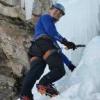Hiking Blister Prevention, Treatment, and Care
Blisters are a very common hiking injury. Blisters can cause a trip to become very uncomfortable, and in worse case scenarios they can slow you down significantly causing unintended consequences. I find a small first aid kit with a few specific items and some practice will eliminate most foot issues, and will quickly alleviate small problems before the blisters and related problems get big.
Preventing blisters from happening is the first step when it comes to backpacking and hiking blister strategy.
Blister Prevention
Blister prevention is the first step. A comfortable shoe with a quality sock is the best cure, and some people find special insoles helpful. I use trail runners with an insole and Darn Tough Light Hiker wool quarter socks, and I tend to check the socks position on my foot a few miles into a trip to make sure it has not bunched up, causing a friction point. Products such as Bodyglide anti-chafe balm can help to waterproof and protect skin, as well as reduce friction and chafing. The second step to prevention is to tape hotspots. On long uphill hikes, I normally will feel a bit of rubbing on my heels, so I will stop and spend 5 minutes applying a few strips of tape on the back of my heel before continuing. Hotspots can occur anywhere on your foot and applying some tape will eliminate these spots before they become blisters. The last step to prevention is to keep irritants out of your shoe by using a short hiking gaiter and/or cleaning out your shoes when you feel any debris in them.
Blister Treatment
Secondly, a good foot tape is essential if you do get blisters. I use Leukotape P, which is designed to adhere to skin. White medical tape may work, but I have found that it does not adhere to skin consistently, especially when your feet get sweaty or in an area with a lot of friction like your heel or the bottom of your foot. In especially wet situations, even Leukotape may have issues, so the second item I always carry is tincture of benzoin. This will either come in swabs or in small liquid filled bottles. It can be very messy if it spills, so double bagging is crucial. Benzoin is a brown alcohol based skin protectant that makes the skin extremely tacky, will disinfect it, and also partially seal any open skin. Benzoin will keep the tape where you applied it, and I use it when I have to slit a blister to make sure it has been disinfected. The third item I always carry is some felt moleskin.
The moleskin is designed to be placed around a blister, to keep pressure and friction off the sensitive and swollen area of your foot that is being affected. A fourth item I carry is a small pair of sharp scissors and/or a needle for cutting moleskin and draining a blister as a last resort. Lastly, on longer trips where I may run into some very wet weather for multiple days, I carry a small tube of athlete’s foot cream. There have been trips where my feet have been completely soaked and I've had to hike 12+ hours in very wet conditions. While I always give my feet a chance to dry overnight and swap/wring out socks during the day, athlete’s foot can set in. Athlete’s foot can cause the skin to become itchy, peel, or separate, causing additional blisters and discomfort.
If I fail to prevent a blister, fixing it is next. It is generally suggested that blisters be left alone and not drained if possible. However, if I can’t walk due to the blister, I like to carefully slit and drain a blister using a sterilized needle to reduce the pressure and swelling. Blood filled blisters should be only slit if you can completely disinfect them since they are much more likely to get infected. However, in any case if you do choose to drain a blister the area should be sterilized and kept as clean as possible. After cleaning, slitting, and cleaning again, I apply benzoin to seal it. I then place pre-cut or custom cut moleskin around the blister site, with tape applied over the moleskin and the blister site, overlapping the surrounding skin sufficiently to make sure it will stay on my foot. I can complete a good repair in 10-15 minutes, and can stay on the foot for multiple days. I like to remove any patches at night to let the foot breath; reapplying in the morning before any significant walking. The only time I will not remove the patches is if I think it may cause more damage to the foot.
The Blister Care Kit & Final Thoughts
To summarize my kit includes a roll of Leukotape, 1 oz. tincture of benzoin, one sheet of pre-cut moleskin, a Victorinox Classic Swiss Army Knife, and I will carry a small amount of tolnaftate cream on any trips that I think it might come in handy. These are added to my normal first aid kit, which is a modified American Medical Kits Ultralight/Watertight .3 kit. For further reading, I have found Fixing Your Feet: Prevention and Treatments for Athletes by John Vonhof to be a good reference book on the subject.
Editor's Note: This trail tip by Ted "tmountainnut" Ehrlich originally appeared in Issue 10 of TrailGroove Magazine. You can read the original article here.


0 Comments
Recommended Comments
There are no comments to display.
Create an account or sign in to comment
You need to be a member in order to leave a comment
Create an account
Sign up for a new account in our community. It's easy!
Register a new accountSign in
Already have an account? Sign in here.
Sign In Now